Addressing Healthcare Disparities: An Aboriginal Case Study Analysis
VerifiedAdded on 2022/11/24
|6
|2425
|1
Case Study
AI Summary
This case study examines the Australian healthcare system's challenges in providing equitable care to Aboriginal Australians, using the experience of Aunt Lettie as a focal point. It highlights issues like racism, language barriers, and cultural insensitivity within healthcare settings, which lead to psychological distress, underuse of medical services, and poorer health outcomes. The study emphasizes the need for cultural safety, improved communication, and the inclusion of Indigenous healthcare workers to address disparities. It also explores the impact of social determinants, such as education and economic status, on health outcomes. The analysis proposes solutions, including culturally competent training for healthcare professionals, reconciliation action plans, and a focus on addressing systemic inequalities to improve healthcare access and outcomes for Aboriginal communities. The case study draws on research and statistics from various sources to support its findings and recommendations, advocating for a more equitable and respectful healthcare system for Indigenous Australians. The study concludes by emphasizing the importance of addressing racism and cultural barriers to improve the overall health and well-being of Aboriginal and Torres Strait Islander peoples.
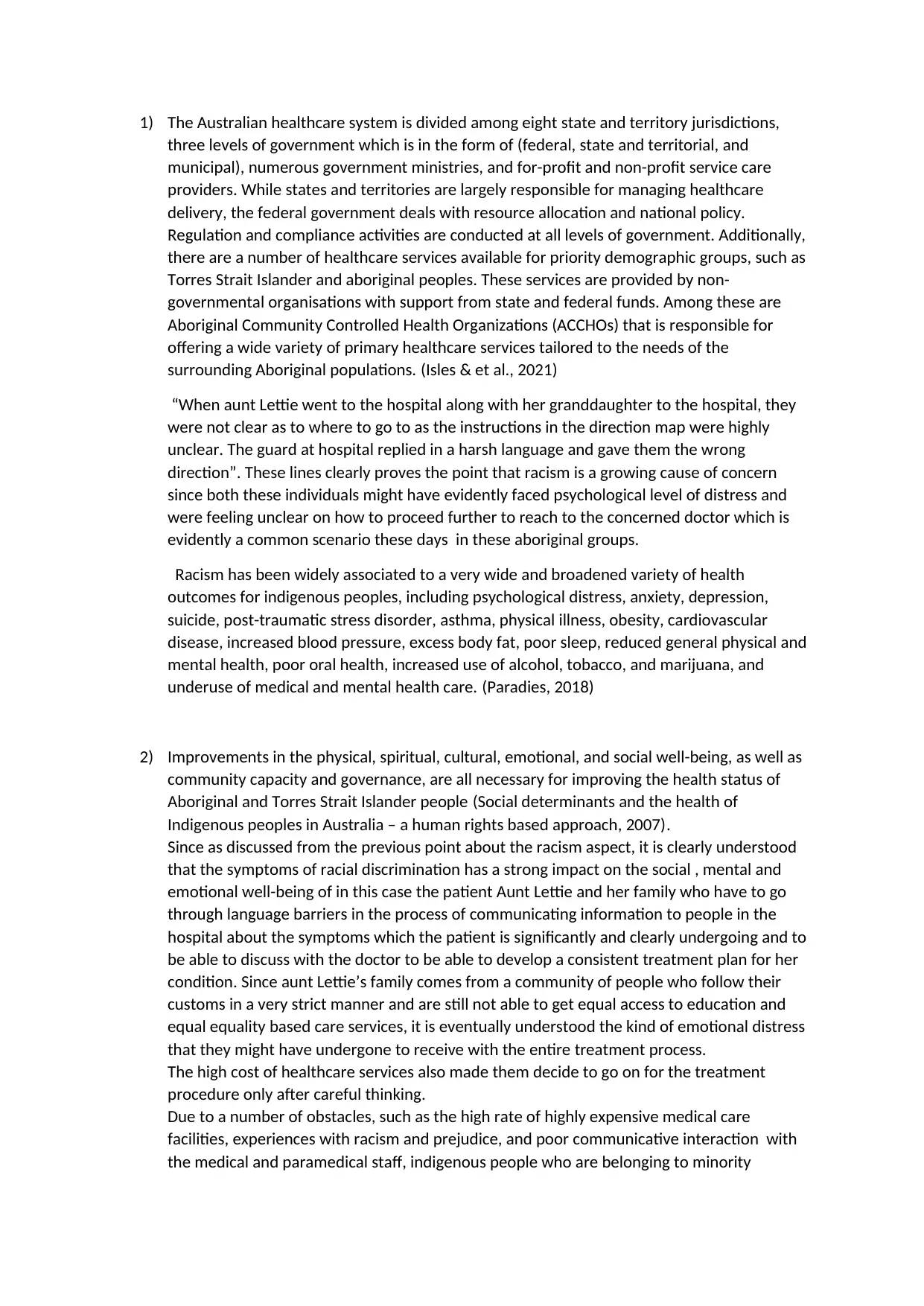
1) The Australian healthcare system is divided among eight state and territory jurisdictions,
three levels of government which is in the form of (federal, state and territorial, and
municipal), numerous government ministries, and for-profit and non-profit service care
providers. While states and territories are largely responsible for managing healthcare
delivery, the federal government deals with resource allocation and national policy.
Regulation and compliance activities are conducted at all levels of government. Additionally,
there are a number of healthcare services available for priority demographic groups, such as
Torres Strait Islander and aboriginal peoples. These services are provided by non-
governmental organisations with support from state and federal funds. Among these are
Aboriginal Community Controlled Health Organizations (ACCHOs) that is responsible for
offering a wide variety of primary healthcare services tailored to the needs of the
surrounding Aboriginal populations. (Isles & et al., 2021)
“When aunt Lettie went to the hospital along with her granddaughter to the hospital, they
were not clear as to where to go to as the instructions in the direction map were highly
unclear. The guard at hospital replied in a harsh language and gave them the wrong
direction”. These lines clearly proves the point that racism is a growing cause of concern
since both these individuals might have evidently faced psychological level of distress and
were feeling unclear on how to proceed further to reach to the concerned doctor which is
evidently a common scenario these days in these aboriginal groups.
Racism has been widely associated to a very wide and broadened variety of health
outcomes for indigenous peoples, including psychological distress, anxiety, depression,
suicide, post-traumatic stress disorder, asthma, physical illness, obesity, cardiovascular
disease, increased blood pressure, excess body fat, poor sleep, reduced general physical and
mental health, poor oral health, increased use of alcohol, tobacco, and marijuana, and
underuse of medical and mental health care. (Paradies, 2018)
2) Improvements in the physical, spiritual, cultural, emotional, and social well-being, as well as
community capacity and governance, are all necessary for improving the health status of
Aboriginal and Torres Strait Islander people (Social determinants and the health of
Indigenous peoples in Australia – a human rights based approach, 2007).
Since as discussed from the previous point about the racism aspect, it is clearly understood
that the symptoms of racial discrimination has a strong impact on the social , mental and
emotional well-being of in this case the patient Aunt Lettie and her family who have to go
through language barriers in the process of communicating information to people in the
hospital about the symptoms which the patient is significantly and clearly undergoing and to
be able to discuss with the doctor to be able to develop a consistent treatment plan for her
condition. Since aunt Lettie’s family comes from a community of people who follow their
customs in a very strict manner and are still not able to get equal access to education and
equal equality based care services, it is eventually understood the kind of emotional distress
that they might have undergone to receive with the entire treatment process.
The high cost of healthcare services also made them decide to go on for the treatment
procedure only after careful thinking.
Due to a number of obstacles, such as the high rate of highly expensive medical care
facilities, experiences with racism and prejudice, and poor communicative interaction with
the medical and paramedical staff, indigenous people who are belonging to minority
three levels of government which is in the form of (federal, state and territorial, and
municipal), numerous government ministries, and for-profit and non-profit service care
providers. While states and territories are largely responsible for managing healthcare
delivery, the federal government deals with resource allocation and national policy.
Regulation and compliance activities are conducted at all levels of government. Additionally,
there are a number of healthcare services available for priority demographic groups, such as
Torres Strait Islander and aboriginal peoples. These services are provided by non-
governmental organisations with support from state and federal funds. Among these are
Aboriginal Community Controlled Health Organizations (ACCHOs) that is responsible for
offering a wide variety of primary healthcare services tailored to the needs of the
surrounding Aboriginal populations. (Isles & et al., 2021)
“When aunt Lettie went to the hospital along with her granddaughter to the hospital, they
were not clear as to where to go to as the instructions in the direction map were highly
unclear. The guard at hospital replied in a harsh language and gave them the wrong
direction”. These lines clearly proves the point that racism is a growing cause of concern
since both these individuals might have evidently faced psychological level of distress and
were feeling unclear on how to proceed further to reach to the concerned doctor which is
evidently a common scenario these days in these aboriginal groups.
Racism has been widely associated to a very wide and broadened variety of health
outcomes for indigenous peoples, including psychological distress, anxiety, depression,
suicide, post-traumatic stress disorder, asthma, physical illness, obesity, cardiovascular
disease, increased blood pressure, excess body fat, poor sleep, reduced general physical and
mental health, poor oral health, increased use of alcohol, tobacco, and marijuana, and
underuse of medical and mental health care. (Paradies, 2018)
2) Improvements in the physical, spiritual, cultural, emotional, and social well-being, as well as
community capacity and governance, are all necessary for improving the health status of
Aboriginal and Torres Strait Islander people (Social determinants and the health of
Indigenous peoples in Australia – a human rights based approach, 2007).
Since as discussed from the previous point about the racism aspect, it is clearly understood
that the symptoms of racial discrimination has a strong impact on the social , mental and
emotional well-being of in this case the patient Aunt Lettie and her family who have to go
through language barriers in the process of communicating information to people in the
hospital about the symptoms which the patient is significantly and clearly undergoing and to
be able to discuss with the doctor to be able to develop a consistent treatment plan for her
condition. Since aunt Lettie’s family comes from a community of people who follow their
customs in a very strict manner and are still not able to get equal access to education and
equal equality based care services, it is eventually understood the kind of emotional distress
that they might have undergone to receive with the entire treatment process.
The high cost of healthcare services also made them decide to go on for the treatment
procedure only after careful thinking.
Due to a number of obstacles, such as the high rate of highly expensive medical care
facilities, experiences with racism and prejudice, and poor communicative interaction with
the medical and paramedical staff, indigenous people who are belonging to minority
Paraphrase This Document
Need a fresh take? Get an instant paraphrase of this document with our AI Paraphraser
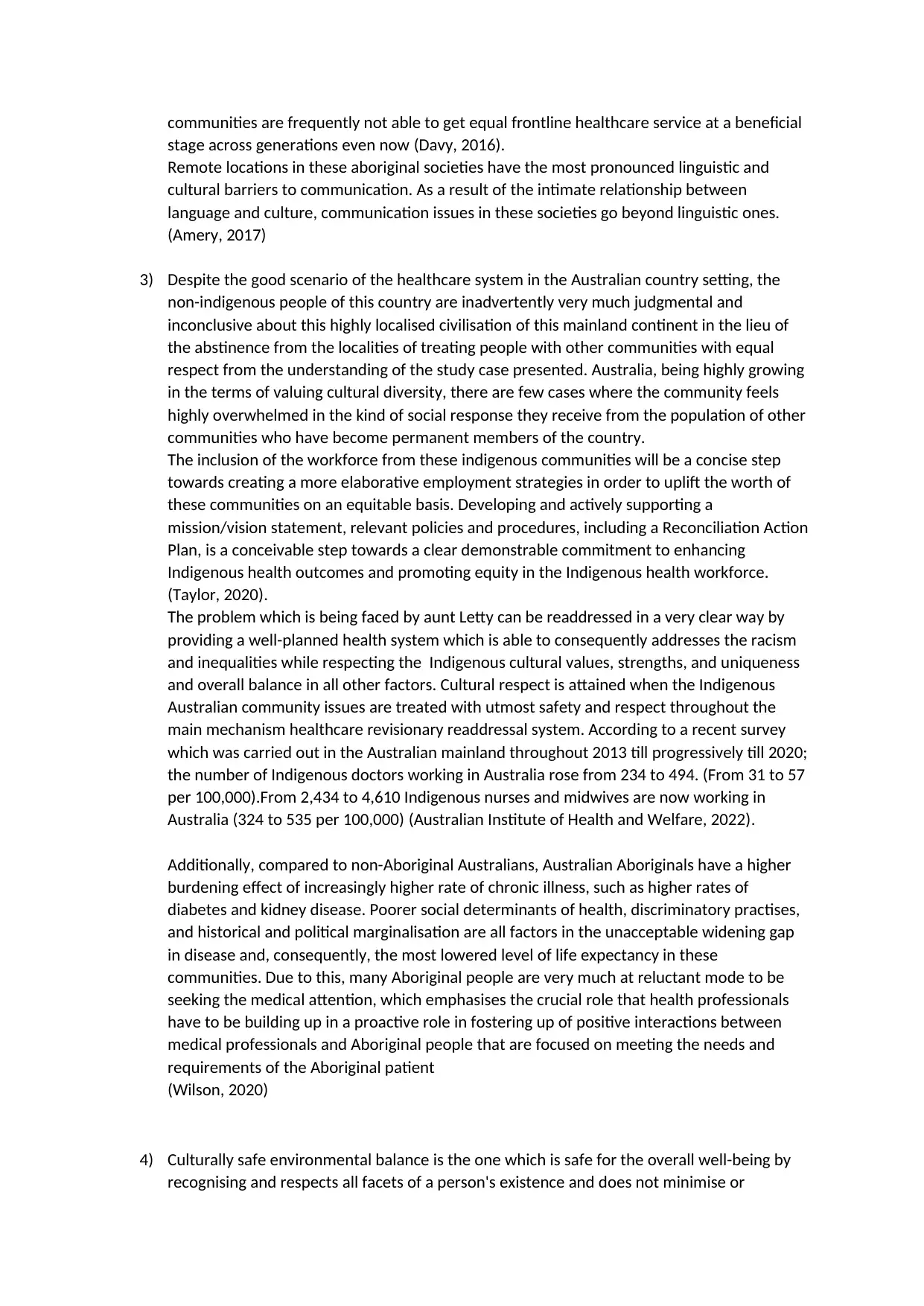
communities are frequently not able to get equal frontline healthcare service at a beneficial
stage across generations even now (Davy, 2016).
Remote locations in these aboriginal societies have the most pronounced linguistic and
cultural barriers to communication. As a result of the intimate relationship between
language and culture, communication issues in these societies go beyond linguistic ones.
(Amery, 2017)
3) Despite the good scenario of the healthcare system in the Australian country setting, the
non-indigenous people of this country are inadvertently very much judgmental and
inconclusive about this highly localised civilisation of this mainland continent in the lieu of
the abstinence from the localities of treating people with other communities with equal
respect from the understanding of the study case presented. Australia, being highly growing
in the terms of valuing cultural diversity, there are few cases where the community feels
highly overwhelmed in the kind of social response they receive from the population of other
communities who have become permanent members of the country.
The inclusion of the workforce from these indigenous communities will be a concise step
towards creating a more elaborative employment strategies in order to uplift the worth of
these communities on an equitable basis. Developing and actively supporting a
mission/vision statement, relevant policies and procedures, including a Reconciliation Action
Plan, is a conceivable step towards a clear demonstrable commitment to enhancing
Indigenous health outcomes and promoting equity in the Indigenous health workforce.
(Taylor, 2020).
The problem which is being faced by aunt Letty can be readdressed in a very clear way by
providing a well-planned health system which is able to consequently addresses the racism
and inequalities while respecting the Indigenous cultural values, strengths, and uniqueness
and overall balance in all other factors. Cultural respect is attained when the Indigenous
Australian community issues are treated with utmost safety and respect throughout the
main mechanism healthcare revisionary readdressal system. According to a recent survey
which was carried out in the Australian mainland throughout 2013 till progressively till 2020;
the number of Indigenous doctors working in Australia rose from 234 to 494. (From 31 to 57
per 100,000).From 2,434 to 4,610 Indigenous nurses and midwives are now working in
Australia (324 to 535 per 100,000) (Australian Institute of Health and Welfare, 2022).
Additionally, compared to non-Aboriginal Australians, Australian Aboriginals have a higher
burdening effect of increasingly higher rate of chronic illness, such as higher rates of
diabetes and kidney disease. Poorer social determinants of health, discriminatory practises,
and historical and political marginalisation are all factors in the unacceptable widening gap
in disease and, consequently, the most lowered level of life expectancy in these
communities. Due to this, many Aboriginal people are very much at reluctant mode to be
seeking the medical attention, which emphasises the crucial role that health professionals
have to be building up in a proactive role in fostering up of positive interactions between
medical professionals and Aboriginal people that are focused on meeting the needs and
requirements of the Aboriginal patient
(Wilson, 2020)
4) Culturally safe environmental balance is the one which is safe for the overall well-being by
recognising and respects all facets of a person's existence and does not minimise or
stage across generations even now (Davy, 2016).
Remote locations in these aboriginal societies have the most pronounced linguistic and
cultural barriers to communication. As a result of the intimate relationship between
language and culture, communication issues in these societies go beyond linguistic ones.
(Amery, 2017)
3) Despite the good scenario of the healthcare system in the Australian country setting, the
non-indigenous people of this country are inadvertently very much judgmental and
inconclusive about this highly localised civilisation of this mainland continent in the lieu of
the abstinence from the localities of treating people with other communities with equal
respect from the understanding of the study case presented. Australia, being highly growing
in the terms of valuing cultural diversity, there are few cases where the community feels
highly overwhelmed in the kind of social response they receive from the population of other
communities who have become permanent members of the country.
The inclusion of the workforce from these indigenous communities will be a concise step
towards creating a more elaborative employment strategies in order to uplift the worth of
these communities on an equitable basis. Developing and actively supporting a
mission/vision statement, relevant policies and procedures, including a Reconciliation Action
Plan, is a conceivable step towards a clear demonstrable commitment to enhancing
Indigenous health outcomes and promoting equity in the Indigenous health workforce.
(Taylor, 2020).
The problem which is being faced by aunt Letty can be readdressed in a very clear way by
providing a well-planned health system which is able to consequently addresses the racism
and inequalities while respecting the Indigenous cultural values, strengths, and uniqueness
and overall balance in all other factors. Cultural respect is attained when the Indigenous
Australian community issues are treated with utmost safety and respect throughout the
main mechanism healthcare revisionary readdressal system. According to a recent survey
which was carried out in the Australian mainland throughout 2013 till progressively till 2020;
the number of Indigenous doctors working in Australia rose from 234 to 494. (From 31 to 57
per 100,000).From 2,434 to 4,610 Indigenous nurses and midwives are now working in
Australia (324 to 535 per 100,000) (Australian Institute of Health and Welfare, 2022).
Additionally, compared to non-Aboriginal Australians, Australian Aboriginals have a higher
burdening effect of increasingly higher rate of chronic illness, such as higher rates of
diabetes and kidney disease. Poorer social determinants of health, discriminatory practises,
and historical and political marginalisation are all factors in the unacceptable widening gap
in disease and, consequently, the most lowered level of life expectancy in these
communities. Due to this, many Aboriginal people are very much at reluctant mode to be
seeking the medical attention, which emphasises the crucial role that health professionals
have to be building up in a proactive role in fostering up of positive interactions between
medical professionals and Aboriginal people that are focused on meeting the needs and
requirements of the Aboriginal patient
(Wilson, 2020)
4) Culturally safe environmental balance is the one which is safe for the overall well-being by
recognising and respects all facets of a person's existence and does not minimise or
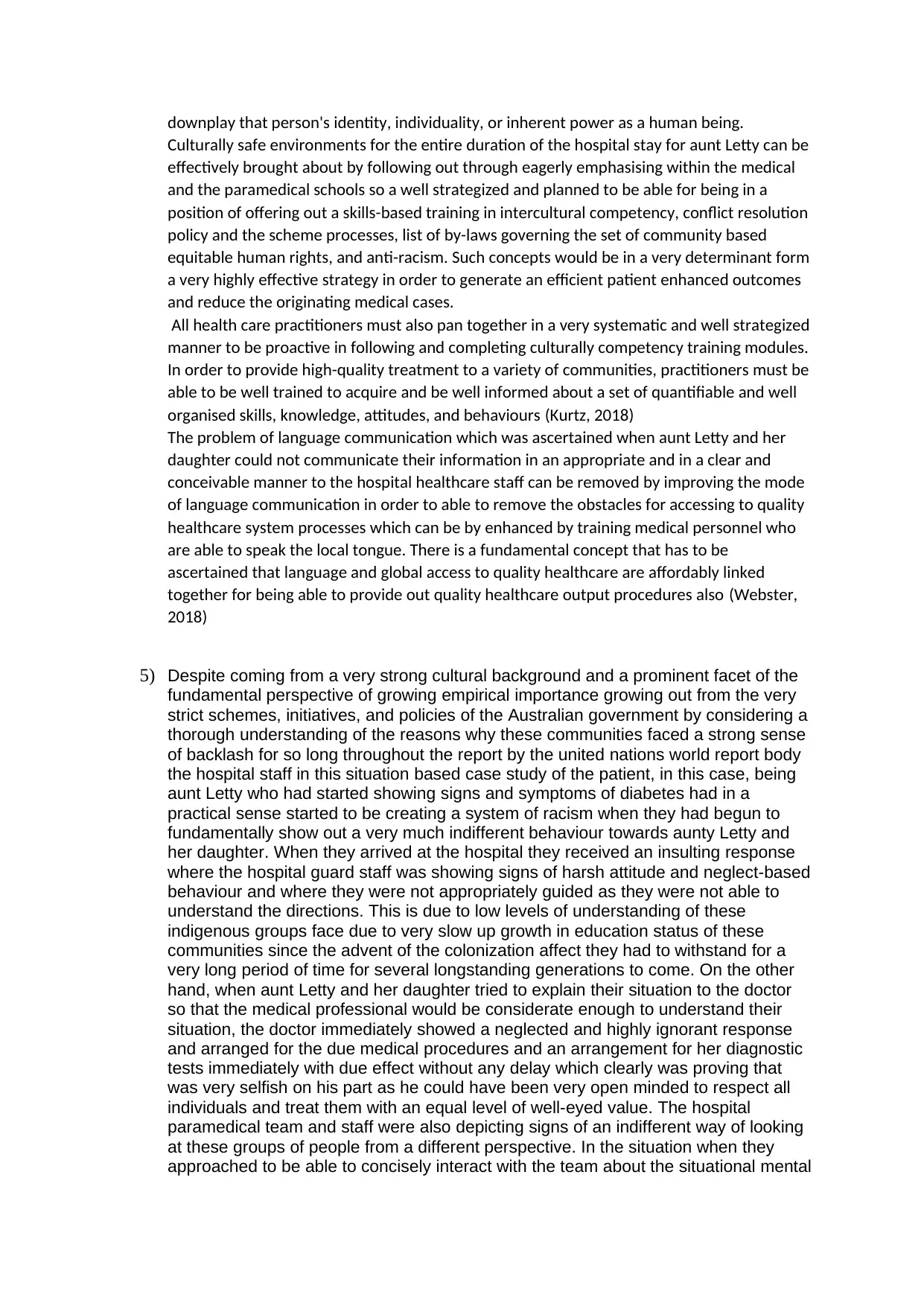
downplay that person's identity, individuality, or inherent power as a human being.
Culturally safe environments for the entire duration of the hospital stay for aunt Letty can be
effectively brought about by following out through eagerly emphasising within the medical
and the paramedical schools so a well strategized and planned to be able for being in a
position of offering out a skills-based training in intercultural competency, conflict resolution
policy and the scheme processes, list of by-laws governing the set of community based
equitable human rights, and anti-racism. Such concepts would be in a very determinant form
a very highly effective strategy in order to generate an efficient patient enhanced outcomes
and reduce the originating medical cases.
All health care practitioners must also pan together in a very systematic and well strategized
manner to be proactive in following and completing culturally competency training modules.
In order to provide high-quality treatment to a variety of communities, practitioners must be
able to be well trained to acquire and be well informed about a set of quantifiable and well
organised skills, knowledge, attitudes, and behaviours (Kurtz, 2018)
The problem of language communication which was ascertained when aunt Letty and her
daughter could not communicate their information in an appropriate and in a clear and
conceivable manner to the hospital healthcare staff can be removed by improving the mode
of language communication in order to able to remove the obstacles for accessing to quality
healthcare system processes which can be by enhanced by training medical personnel who
are able to speak the local tongue. There is a fundamental concept that has to be
ascertained that language and global access to quality healthcare are affordably linked
together for being able to provide out quality healthcare output procedures also (Webster,
2018)
5) Despite coming from a very strong cultural background and a prominent facet of the
fundamental perspective of growing empirical importance growing out from the very
strict schemes, initiatives, and policies of the Australian government by considering a
thorough understanding of the reasons why these communities faced a strong sense
of backlash for so long throughout the report by the united nations world report body
the hospital staff in this situation based case study of the patient, in this case, being
aunt Letty who had started showing signs and symptoms of diabetes had in a
practical sense started to be creating a system of racism when they had begun to
fundamentally show out a very much indifferent behaviour towards aunty Letty and
her daughter. When they arrived at the hospital they received an insulting response
where the hospital guard staff was showing signs of harsh attitude and neglect-based
behaviour and where they were not appropriately guided as they were not able to
understand the directions. This is due to low levels of understanding of these
indigenous groups face due to very slow up growth in education status of these
communities since the advent of the colonization affect they had to withstand for a
very long period of time for several longstanding generations to come. On the other
hand, when aunt Letty and her daughter tried to explain their situation to the doctor
so that the medical professional would be considerate enough to understand their
situation, the doctor immediately showed a neglected and highly ignorant response
and arranged for the due medical procedures and an arrangement for her diagnostic
tests immediately with due effect without any delay which clearly was proving that
was very selfish on his part as he could have been very open minded to respect all
individuals and treat them with an equal level of well-eyed value. The hospital
paramedical team and staff were also depicting signs of an indifferent way of looking
at these groups of people from a different perspective. In the situation when they
approached to be able to concisely interact with the team about the situational mental
Culturally safe environments for the entire duration of the hospital stay for aunt Letty can be
effectively brought about by following out through eagerly emphasising within the medical
and the paramedical schools so a well strategized and planned to be able for being in a
position of offering out a skills-based training in intercultural competency, conflict resolution
policy and the scheme processes, list of by-laws governing the set of community based
equitable human rights, and anti-racism. Such concepts would be in a very determinant form
a very highly effective strategy in order to generate an efficient patient enhanced outcomes
and reduce the originating medical cases.
All health care practitioners must also pan together in a very systematic and well strategized
manner to be proactive in following and completing culturally competency training modules.
In order to provide high-quality treatment to a variety of communities, practitioners must be
able to be well trained to acquire and be well informed about a set of quantifiable and well
organised skills, knowledge, attitudes, and behaviours (Kurtz, 2018)
The problem of language communication which was ascertained when aunt Letty and her
daughter could not communicate their information in an appropriate and in a clear and
conceivable manner to the hospital healthcare staff can be removed by improving the mode
of language communication in order to able to remove the obstacles for accessing to quality
healthcare system processes which can be by enhanced by training medical personnel who
are able to speak the local tongue. There is a fundamental concept that has to be
ascertained that language and global access to quality healthcare are affordably linked
together for being able to provide out quality healthcare output procedures also (Webster,
2018)
5) Despite coming from a very strong cultural background and a prominent facet of the
fundamental perspective of growing empirical importance growing out from the very
strict schemes, initiatives, and policies of the Australian government by considering a
thorough understanding of the reasons why these communities faced a strong sense
of backlash for so long throughout the report by the united nations world report body
the hospital staff in this situation based case study of the patient, in this case, being
aunt Letty who had started showing signs and symptoms of diabetes had in a
practical sense started to be creating a system of racism when they had begun to
fundamentally show out a very much indifferent behaviour towards aunty Letty and
her daughter. When they arrived at the hospital they received an insulting response
where the hospital guard staff was showing signs of harsh attitude and neglect-based
behaviour and where they were not appropriately guided as they were not able to
understand the directions. This is due to low levels of understanding of these
indigenous groups face due to very slow up growth in education status of these
communities since the advent of the colonization affect they had to withstand for a
very long period of time for several longstanding generations to come. On the other
hand, when aunt Letty and her daughter tried to explain their situation to the doctor
so that the medical professional would be considerate enough to understand their
situation, the doctor immediately showed a neglected and highly ignorant response
and arranged for the due medical procedures and an arrangement for her diagnostic
tests immediately with due effect without any delay which clearly was proving that
was very selfish on his part as he could have been very open minded to respect all
individuals and treat them with an equal level of well-eyed value. The hospital
paramedical team and staff were also depicting signs of an indifferent way of looking
at these groups of people from a different perspective. In the situation when they
approached to be able to concisely interact with the team about the situational mental
⊘ This is a preview!⊘
Do you want full access?
Subscribe today to unlock all pages.

Trusted by 1+ million students worldwide
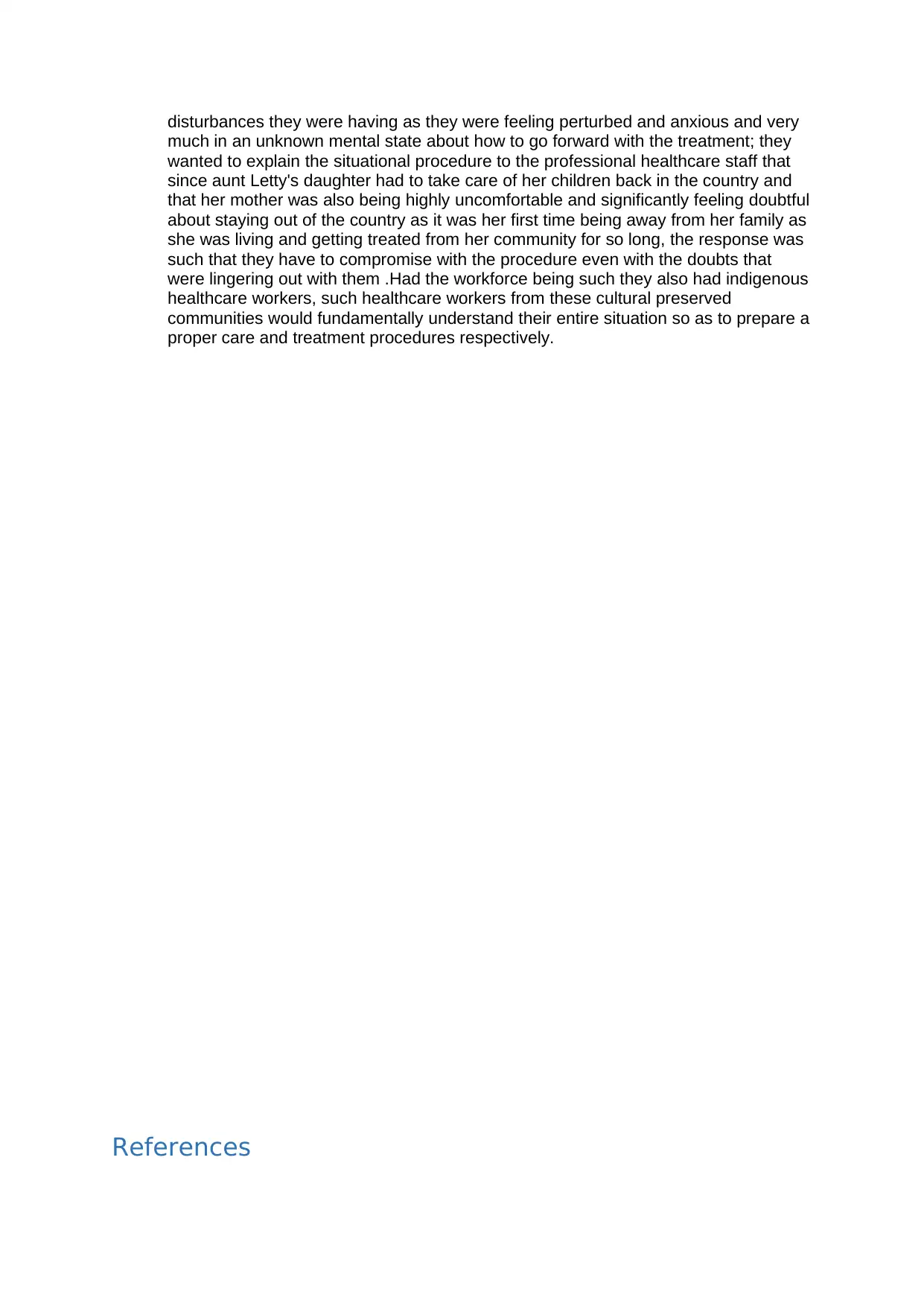
disturbances they were having as they were feeling perturbed and anxious and very
much in an unknown mental state about how to go forward with the treatment; they
wanted to explain the situational procedure to the professional healthcare staff that
since aunt Letty's daughter had to take care of her children back in the country and
that her mother was also being highly uncomfortable and significantly feeling doubtful
about staying out of the country as it was her first time being away from her family as
she was living and getting treated from her community for so long, the response was
such that they have to compromise with the procedure even with the doubts that
were lingering out with them .Had the workforce being such they also had indigenous
healthcare workers, such healthcare workers from these cultural preserved
communities would fundamentally understand their entire situation so as to prepare a
proper care and treatment procedures respectively.
References
much in an unknown mental state about how to go forward with the treatment; they
wanted to explain the situational procedure to the professional healthcare staff that
since aunt Letty's daughter had to take care of her children back in the country and
that her mother was also being highly uncomfortable and significantly feeling doubtful
about staying out of the country as it was her first time being away from her family as
she was living and getting treated from her community for so long, the response was
such that they have to compromise with the procedure even with the doubts that
were lingering out with them .Had the workforce being such they also had indigenous
healthcare workers, such healthcare workers from these cultural preserved
communities would fundamentally understand their entire situation so as to prepare a
proper care and treatment procedures respectively.
References
Paraphrase This Document
Need a fresh take? Get an instant paraphrase of this document with our AI Paraphraser
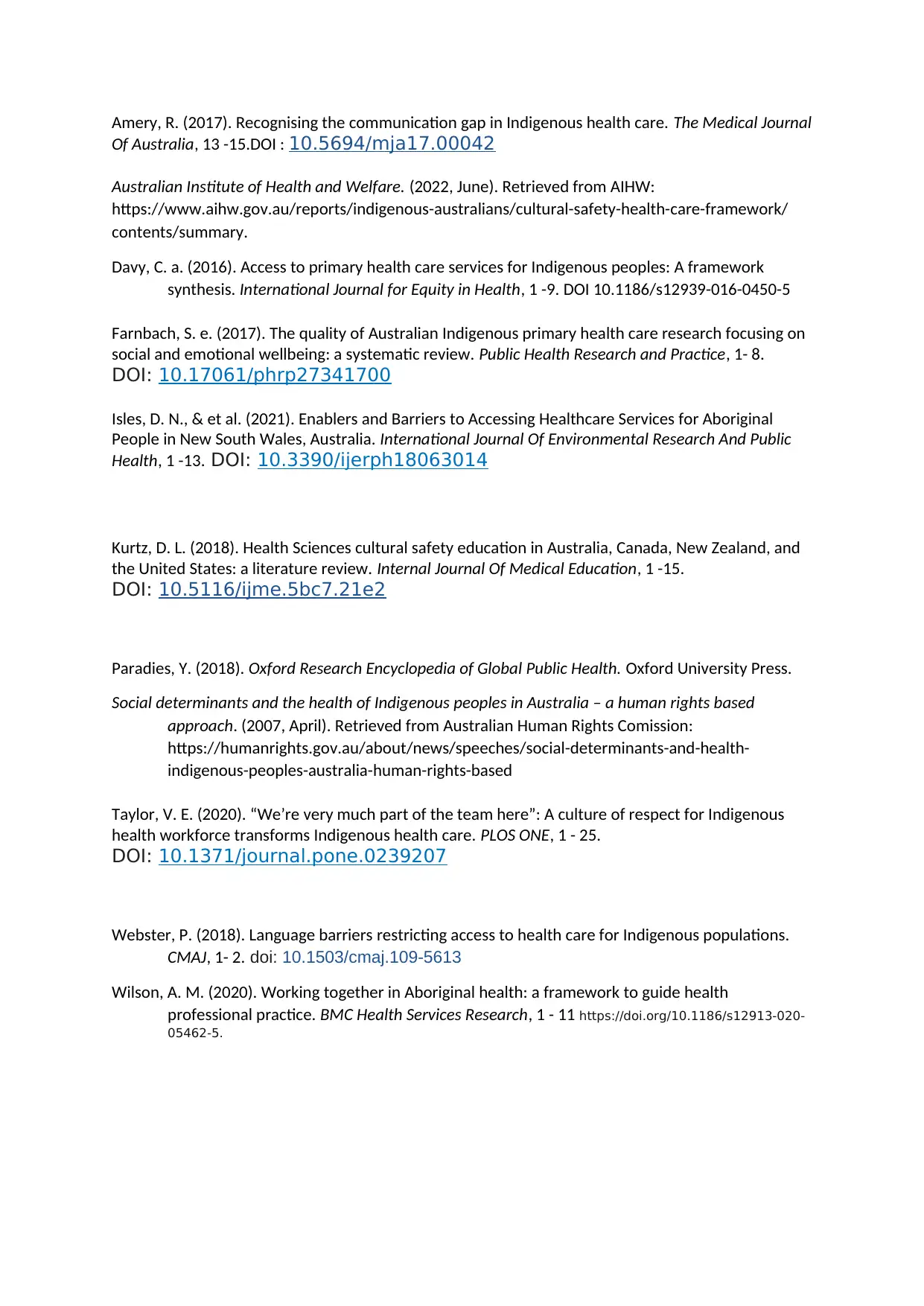
Amery, R. (2017). Recognising the communication gap in Indigenous health care. The Medical Journal
Of Australia, 13 -15.DOI : 10.5694/mja17.00042
Australian Institute of Health and Welfare. (2022, June). Retrieved from AIHW:
https://www.aihw.gov.au/reports/indigenous-australians/cultural-safety-health-care-framework/
contents/summary.
Davy, C. a. (2016). Access to primary health care services for Indigenous peoples: A framework
synthesis. International Journal for Equity in Health, 1 -9. DOI 10.1186/s12939-016-0450-5
Farnbach, S. e. (2017). The quality of Australian Indigenous primary health care research focusing on
social and emotional wellbeing: a systematic review. Public Health Research and Practice, 1- 8.
DOI: 10.17061/phrp27341700
Isles, D. N., & et al. (2021). Enablers and Barriers to Accessing Healthcare Services for Aboriginal
People in New South Wales, Australia. International Journal Of Environmental Research And Public
Health, 1 -13. DOI: 10.3390/ijerph18063014
Kurtz, D. L. (2018). Health Sciences cultural safety education in Australia, Canada, New Zealand, and
the United States: a literature review. Internal Journal Of Medical Education, 1 -15.
DOI: 10.5116/ijme.5bc7.21e2
Paradies, Y. (2018). Oxford Research Encyclopedia of Global Public Health. Oxford University Press.
Social determinants and the health of Indigenous peoples in Australia – a human rights based
approach. (2007, April). Retrieved from Australian Human Rights Comission:
https://humanrights.gov.au/about/news/speeches/social-determinants-and-health-
indigenous-peoples-australia-human-rights-based
Taylor, V. E. (2020). “We’re very much part of the team here”: A culture of respect for Indigenous
health workforce transforms Indigenous health care. PLOS ONE, 1 - 25.
DOI: 10.1371/journal.pone.0239207
Webster, P. (2018). Language barriers restricting access to health care for Indigenous populations.
CMAJ, 1- 2. doi: 10.1503/cmaj.109-5613
Wilson, A. M. (2020). Working together in Aboriginal health: a framework to guide health
professional practice. BMC Health Services Research, 1 - 11 https://doi.org/10.1186/s12913-020-
05462-5.
Of Australia, 13 -15.DOI : 10.5694/mja17.00042
Australian Institute of Health and Welfare. (2022, June). Retrieved from AIHW:
https://www.aihw.gov.au/reports/indigenous-australians/cultural-safety-health-care-framework/
contents/summary.
Davy, C. a. (2016). Access to primary health care services for Indigenous peoples: A framework
synthesis. International Journal for Equity in Health, 1 -9. DOI 10.1186/s12939-016-0450-5
Farnbach, S. e. (2017). The quality of Australian Indigenous primary health care research focusing on
social and emotional wellbeing: a systematic review. Public Health Research and Practice, 1- 8.
DOI: 10.17061/phrp27341700
Isles, D. N., & et al. (2021). Enablers and Barriers to Accessing Healthcare Services for Aboriginal
People in New South Wales, Australia. International Journal Of Environmental Research And Public
Health, 1 -13. DOI: 10.3390/ijerph18063014
Kurtz, D. L. (2018). Health Sciences cultural safety education in Australia, Canada, New Zealand, and
the United States: a literature review. Internal Journal Of Medical Education, 1 -15.
DOI: 10.5116/ijme.5bc7.21e2
Paradies, Y. (2018). Oxford Research Encyclopedia of Global Public Health. Oxford University Press.
Social determinants and the health of Indigenous peoples in Australia – a human rights based
approach. (2007, April). Retrieved from Australian Human Rights Comission:
https://humanrights.gov.au/about/news/speeches/social-determinants-and-health-
indigenous-peoples-australia-human-rights-based
Taylor, V. E. (2020). “We’re very much part of the team here”: A culture of respect for Indigenous
health workforce transforms Indigenous health care. PLOS ONE, 1 - 25.
DOI: 10.1371/journal.pone.0239207
Webster, P. (2018). Language barriers restricting access to health care for Indigenous populations.
CMAJ, 1- 2. doi: 10.1503/cmaj.109-5613
Wilson, A. M. (2020). Working together in Aboriginal health: a framework to guide health
professional practice. BMC Health Services Research, 1 - 11 https://doi.org/10.1186/s12913-020-
05462-5.

⊘ This is a preview!⊘
Do you want full access?
Subscribe today to unlock all pages.

Trusted by 1+ million students worldwide
1 out of 6
Related Documents
Your All-in-One AI-Powered Toolkit for Academic Success.
+13062052269
info@desklib.com
Available 24*7 on WhatsApp / Email
![[object Object]](/_next/static/media/star-bottom.7253800d.svg)
Unlock your academic potential
Copyright © 2020–2025 A2Z Services. All Rights Reserved. Developed and managed by ZUCOL.




